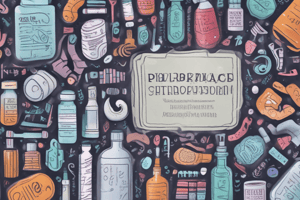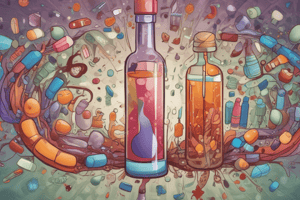Podcast
Questions and Answers
What percentage of all ADRs are on-target (predictable) reactions?
What percentage of all ADRs are on-target (predictable) reactions?
- 80% (correct)
- 50%
- 90%
- 20%
Which of the following is an example of an off-target (unpredictable) reaction?
Which of the following is an example of an off-target (unpredictable) reaction?
- Warfarin-induced bleeding
- Sedation with antihistamines
- Urticaria due to penicillin (correct)
- Antibiotic-associated diarrhea
What is the characteristic of on-target (predictable) reactions in terms of dose?
What is the characteristic of on-target (predictable) reactions in terms of dose?
- Dose-independent
- Unknown dose-response
- Dose-dependent (correct)
- Variable dose-response
What is the term for ADRs that occur on reexposure to a drug or during the second week of a course of treatment?
What is the term for ADRs that occur on reexposure to a drug or during the second week of a course of treatment?
What is the characteristic of antibody-mediated (immunologic) reactions in terms of dose?
What is the characteristic of antibody-mediated (immunologic) reactions in terms of dose?
What is the term for ADRs that can be explained by the known pharmacology of the drug?
What is the term for ADRs that can be explained by the known pharmacology of the drug?
According to Health Canada, what is an adverse reaction to?
According to Health Canada, what is an adverse reaction to?
What is an example of a secondary effect of a drug?
What is an example of a secondary effect of a drug?
What percentage of hospitalized patients will experience an adverse drug reaction?
What percentage of hospitalized patients will experience an adverse drug reaction?
What is the term for ADRs that do not exhibit a simple relationship between dose and occurrence of toxicity?
What is the term for ADRs that do not exhibit a simple relationship between dose and occurrence of toxicity?
What is the estimated annual cost of adverse drug reactions on healthcare?
What is the estimated annual cost of adverse drug reactions on healthcare?
What is the ranking of adverse drug reactions as a cause of death?
What is the ranking of adverse drug reactions as a cause of death?
What is the primary challenge in determining whether a reaction is an adverse drug reaction?
What is the primary challenge in determining whether a reaction is an adverse drug reaction?
What is the goal of causality assessment in adverse drug reactions?
What is the goal of causality assessment in adverse drug reactions?
When did the reaction occur in relation to the drug is an important question in causality assessment because it helps to
When did the reaction occur in relation to the drug is an important question in causality assessment because it helps to
What is the purpose of stopping the suspected drug or providing specific treatment in causality assessment?
What is the purpose of stopping the suspected drug or providing specific treatment in causality assessment?
What percentage of ADRs leading to outpatient visits are caused by antibiotics?
What percentage of ADRs leading to outpatient visits are caused by antibiotics?
Which of the following is NOT a common cause of ADRs leading to hospital admission?
Which of the following is NOT a common cause of ADRs leading to hospital admission?
What is the percentage of ADRs leading to ED visits caused by opioids?
What is the percentage of ADRs leading to ED visits caused by opioids?
Which of the following excipients may cause ADRs in patients with hypersensitivity?
Which of the following excipients may cause ADRs in patients with hypersensitivity?
What is the percentage of ADRs leading to hospital admission caused by warfarin?
What is the percentage of ADRs leading to hospital admission caused by warfarin?
According to Pirmohamed et al., what percentage of ADRs are caused by diuretics?
According to Pirmohamed et al., what percentage of ADRs are caused by diuretics?
Flashcards are hidden until you start studying
Study Notes
Adverse Drug Reactions (ADRs)
- ADRs are undesirable effects to health products, including drugs, medical devices, and natural health products.
- According to Health Canada, ADRs include both prescription and non-prescription pharmaceuticals.
- WHO defines ADRs as any noxious and unintended response to a medicinal product.
Importance of ADRs
- ADRs are common, affecting 30% of hospitalized patients.
- ADRs are expensive, with an estimated annual healthcare cost of $136 billion.
- ADRs can be serious, with serious/fatal reactions being the fifth leading cause of death.
- ADRs are often preventable.
Recognizing ADRs
- ADR detection can be easy or challenging, depending on the patient's medication history and other complicating factors.
- Causality assessment is necessary to determine the probability of association between the drug and the reaction.
Causality Assessment
- Determine the probability of association by considering:
- When did the reaction occur in relation to the drug?
- Did the reaction occur only after the drug was started?
- Did anything else change around the time of the ADR?
- Did the reaction improve when the drug was stopped or specific treatment given?
- Was there ever intentional or accidental use of the drug following the ADR?
Drugs Causing ADRs
- Outpatient leading to admission to hospital:
- NSAIDs (30%)
- Diuretics (27%)
- Warfarin (11%)
- ACEI/ARBs (8%)
- Antidepressants (7%)
- Beta-blockers (7%)
- Opioids (6%)
- Outpatient leading to ED visits:
- Anticoagulants (17.6%)
- Antibiotics (16.1%)
- Diabetes agents (13.3%)
- Opioids (6.8%)
- Antiplatelets (6.6%)
- Consider excipients, especially in patients with hypersensitivity to systemic corticosteroids, vaccines, and biologics.
Classification of ADRs
- Predictable Reactions ("on-target" ADRs):
- Augmentation of the pharmacology of the drug
- Dose-dependent
- 80% of all ADRs
- Unpredictable Reactions ("off-target" ADRs):
- Cannot be explained by the known pharmacology of the drug
- Do not exhibit a simple relationship between dose and occurrence of toxicity
Predictable Reactions
- Examples:
- Toxicity: hepatic failure with high-dose acetaminophen
- Side effect: sedation with antihistamines
- Secondary effect: development of diarrhea with antibiotic treatment
- Drug interaction: theophylline toxicity with concomitant erythromycin
Unpredictable Reactions
- Antibody-mediated (immunologic) reactions:
- Occur on reexposure to a drug or during the second week of a course of treatment
- Occur at lower doses than required for pharmacologic effect
- Produce reactions that are characteristic of known allergic drug reactions (e.g., urticaria, angioedema)
- Symptoms usually subside within 3 to 5 days after drug discontinuation
Studying That Suits You
Use AI to generate personalized quizzes and flashcards to suit your learning preferences.




